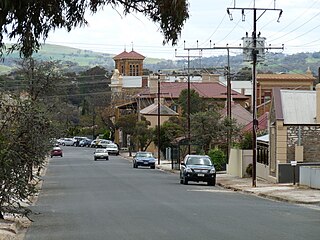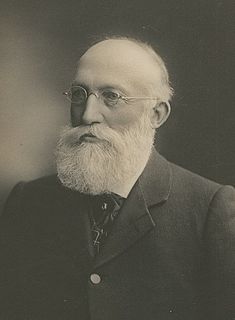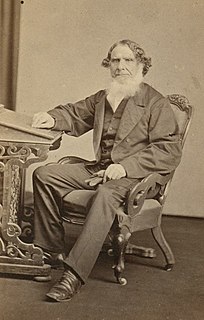Related Research Articles

Kapunda is a town on the Light River and near the Barossa Valley in South Australia. It was established after a discovery in 1842 of significant copper deposits. The population was 2,917 at the 2016 Australian Census.

Vaiben Louis Solomon was the 21st Premier of South Australia and a member of the first Australian Commonwealth parliament. He was generally known by his full name.
Adelaide Educational Institution was a privately run non-sectarian academy for boys in Adelaide founded in 1852 by John Lorenzo Young.
He avoided rote learning, punishment and religious instruction, but taught moral philosophy, physiology, political economy and mechanical drawing ... (and) surveying on field trips.
George Scarfe was a merchant in Adelaide, South Australia, a partner in the firm of George P. Harris, Scarfe, & Co., later known as Harris Scarfe. Called a "genius of commerce", he was largely credited with the firm's early success and gained great personal wealth. His brother T. R. Scarfe (1843–1915), nephew F. G. Scarfe (1867–1961) and Frederick George's son-in-law C. C. Deeley were prominent in the 20th century development of the company.

The Queen's Theatre is a building of historic importance in Playhouse Lane, Adelaide, South Australia. It is the oldest intact theatre in mainland Australia, having originally been built in 1840, the only earlier one in Australia being the still-operational Theatre Royal in Hobart, Tasmania. It was not the first theatre to open in Adelaide however; there were two earlier, less sophisticated earlier venues created in 1838–9.
Samuel Moss Solomon was an early Jewish settler in Australia, amongst whose descendants many achieved a degree of notability. The relationship between these descendants is complicated by three factors: the duplication of names, not only within a family line but across lines; the number of intra-family marriages; and marriages to people with the same surname but not closely related. This list is not exhaustive but includes most family members likely to be found in Wikipedia and Australian newspapers.

Edward John Woods F.R.I.B.A. was a prominent architect in the early days of South Australia.

The Southern Argus is a newspaper first published from March 1866 in Port Elliot, South Australia, and then in Strathalbyn from 1868 to the present. It is published on Thursdays.
Edward Angus Hamilton was an architect and politician in colonial South Australia.

Emanuel Solomon was a businessman and politician in the early days of the Colony of South Australia
Vaiben Solomon was a London Jew who, with his brother Emanuel Solomon, was transported for larceny to New South Wales in 1818. He had further brushes with the law but seized business opportunities and became quite prosperous. He and his brother were then joined by a contingent of brothers and sisters who made their mark in New South Wales and South Australian business and politics.
The Kapunda Herald was a newspaper published in Kapunda, South Australia from 29 October 1864 to 25 January 1951. From 1864 to 1878 the masthead was subtitled "and Northern Intelligencer". It was published weekly, except for the period February 1872 to September 1894 when it appeared bi-weekly. When closed, the newspaper was merged with the Barossa News to become the Barossa and Light Herald.
Emanuel Cohen was businessman in South Australia, and was responsible for the erection of several of Adelaide's premier buildings.
Patrick Gay was a cabinetmaker and businessmen of Adelaide, South Australia, for whom Gay's Arcade was named.
David Gall was a printer in the early days of colonial South Australia.
Charles James Fox BA was a newspaper editor and owner in Australia.
Laurie Phillip Lawrence was a businessman and philanthropist in South Australia.
George Peter Harris was the co-founder of the South Australian company that became Harris Scarfe.
Charles Williams was head brewer for several notable Australian companies.
James Marshall & Co. was a department store in Adelaide, South Australia, which was taken over by Myer in 1928.
References
- ↑ "Tram Fare Increases". The Examiner (Tasmania) . Tasmania, Australia. 20 June 1918. p. 6. Retrieved 23 April 2020– via Trove.
- ↑ "Hackneyed Phrases". The Braidwood Dispatch and Mining Journal . New South Wales, Australia. 16 June 1897. p. 4. Retrieved 23 April 2020– via Trove.
- ↑ "Advertising". The Adelaide Observer . South Australia. 1 February 1845. p. 2. Retrieved 23 April 2020– via Trove.
- ↑ "Advertising". The Adelaide Express . South Australia. 15 October 1866. p. 1. Retrieved 23 April 2020– via Trove.
- ↑ "Building Improvements in the City". The South Australian Advertiser . South Australia. 16 January 1867. p. 2. Retrieved 23 April 2020– via Trove.
- ↑ "Law and Criminal Courts". South Australian Register . South Australia. 13 July 1869. p. 3. Retrieved 23 April 2020– via Trove.
- 1 2 "The Adjourned Inquest on the Fire at the Nimble Ninepence". The Evening Journal (Adelaide) . South Australia. 3 November 1871. p. 3. Retrieved 23 April 2020– via Trove.
- ↑ "Destructive Fire in King William Street". South Australian Register . South Australia. 1 November 1871. p. 5. Retrieved 23 April 2020– via Trove.
- ↑ "A Very Good View of the Matter". Melbourne Punch . Victoria, Australia. 4 April 1872. p. 1. Retrieved 23 April 2020– via Trove.